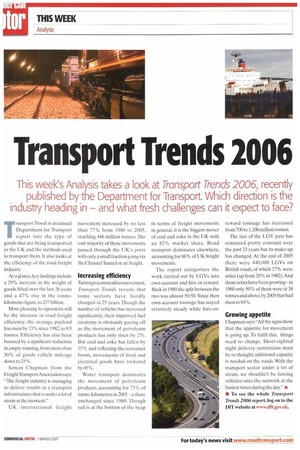Transport Trends 2006
Page 20

If you've noticed an error in this article please click here to report it so we can fix it.
This week's Analysis takes a look at Transport Trends 2006, recently published by the Department for Transport. Which direction is the industry heading in — and what fresh challenges can it expect to face?
Transport Trends is an annual Department for Transport report into the type of goods that are being transported in the UK and the methods used to transport them. It also looks at the efficiency of the road freight industry.
At a glance, key findings include a 29% increase in the weight of goods lifted over the last 26 years and a 47% rise in the tonnekilometre figure, to 257 billion.
Most pleasing to operators will be the increase in road freight efficiency; the average payload has risen by 13% since 1982, to 9.5 tonnes. Efficiency has also been boosted by a significant reduction in empty running, from more than 30% of goods vehicle mileage down to 25%.
Simon Chapman from the Freight Transport Association says: "The freight industry is managing to deliver results in a transport infrastructure that is under a lot of strain at the moment."
UK international freight movement increased by no less than 77% from 1980 to 2005, reaching 446 million tonnes. The vast majority of these movements passed through the UK's ports with only a small fraction going via the ChannelTunnel or air freight.
Increasing efficiency
Turningtocommoditiesmovement, Transport Trends reveals that some sectors have hardly changed in 25 years. Though the number of vehicles has increased significantly, their improved fuel economy is obviously paying off as the movement of petroleum products has only risen by 2%. But coal and coke has fallen by 15% and reflecting the consumer boom, movements of food and electrical goods have rocketed by 85%.
Water transport dominates the movement of petroleum products, accounting for 73% of tonne-kilometres in 2005 — a share unchanged since 1980. Though rail is at the bottom of the heap in terms of freight movements in general, it is the biggest mover of coal and coke in the UK with an 82% market share. Road transport dominates elsewhere, accounting for 86% of UK freight movement& The report categorises the work carried out by LGVs into own-account and hire or reward. Back in 1980 the split between the two was almost 50:50. Since then own-account tonnage has stayed relatively steady while hire-or reward tonnage has increased from 700 to 1,100 million tonnes.
The size of the LGV pare has remained pretty constant over the past 23 years but its make-up has changed. At the end of 2005 there were 440,000 LGVs on British roads, of which 27% were artics (up from 20% in 1982). And those artics have been growing—in 1988 only 50% of them were at 38 tonnes and above; by 2005 that had risen to 84%.
Growing appetite
Chapman says:-All the signs show that the appetite for movement is going up. To fulfil this, things need to change. Short-sighted night delivery restrictions must be re-thought; additional capacity is needed on the roads. With the transport sector under a lot of strain, we shouldn't be forcing vehicles onto the network at the busiest times during the day." • • To see the whole Transport Trends 2006 report, log on to the Dff website at www.dft.gov.uk.


























































































































































































